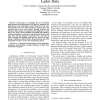Free Online Productivity Tools
i2Speak
i2Symbol
i2OCR
iTex2Img
iWeb2Print
iWeb2Shot
i2Type
iPdf2Split
iPdf2Merge
i2Bopomofo
i2Arabic
i2Style
i2Image
i2PDF
iLatex2Rtf
Sci2ools
IJRR
2006
2006
Unmanned Ground Vehicle Navigation Using Aerial Ladar Data
In this paper, we investigate the use of overhead high-resolution three-dimensional (3-D) data for enhancing the performances of an Unmanned Ground Vehicle (UGV) in vegetated terrains. Data were collected using an airborne laser and provided prior to the robot mission. Through extensive and exhaustive field testing, we demonstrate the significance of such data in two areas: robot localization and global path planning. Absolute localization is achieved by registering 3-D local ground ladar data with the global 3-D aerial data. The same data is used to compute traversability maps that are used by the path planner. Vegetation is filtered both in the ground data and in the aerial data in order to recover the load bearing surface.
| Added | 13 Dec 2010 |
| Updated | 13 Dec 2010 |
| Type | Journal |
| Year | 2006 |
| Where | IJRR |
| Authors | Nicolas Vandapel, Raghavendra Donamukkala, Martial Hebert |
Comments (0)

